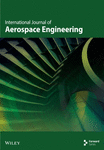Multiperspective Structural Integrity Investigations on the Rotor Blade of Axial Flow Compressor Under Various Rotodynamic Loading Conditions Using Enhanced Computational Analyses
Abstract
Small gas turbine (SGT) engines power the latest generation of unmanned aerial vehicles (UAVs). This study investigates the axial flow–natured rotor blades of an SGT compressor. Rotor structures in axial flow compressors have failed due to complex stress scenarios. Lightweight, high-resistance material can reduce the failure rate of axial flow compressors in fixed-wing UAVs. Compressor blade designs are completed in 3DEXPERIENCE after extensive material investigation, in which the design data are evaluated through standard analytical procedures. First, an axial flow compressor blade for a long-range UAV is analyzed using computational fluid dynamics, in which imposed the complicated rotodynamic conditions in a single moving reference frame to the axial flow compressor rotor blade. Curvature and proximity discretization are employed in conjunction with ANSYS Mesh in this study. The edges and faces are scaled by a local mesh facility. Because of the intricate nature of the flow, an enhanced wall treatment turbulence model based on the k-epsilon parameter was employed. The computational method based on fluid-structure interaction (FSI) uses aerodynamic pressure distributions on the compressor blade as a basis for structural analyses. For this structural investigation, FSI has been used with a single-coupling direction. Composite compressor blades are put through an FSI inspection to ensure they are perfect. Epoxy has been used to analyze the structural integrity of a variety of modern composites, including those made from carbon fiber–reinforced polymers, glass fiber–reinforced polymers, and Kevlar fiber–reinforced polymers. Researchers used ANSYS Workbench to conduct in-depth analyses of over 25 lightweight materials. The blades are free to move in reaction to a shift in position at low, medium, and high rotational speeds, while the main hub remains stationary. This study lays the door for the development of axial flow compressors using nontraditional lightweight high-resistance materials.
Conflicts of Interest
The authors declare no conflicts of interest.
Open Research
Data Availability Statement
The authors confirm that the data supporting the findings of this study are available within the article.




